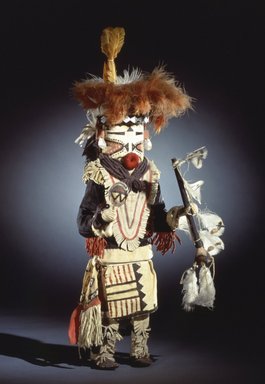
Artist:A:shiwi (Zuni Pueblo)
Medium: Wood, pigment, horsehair, feathers, wool, hide, cotton, tin, ribbon
Geograhical Locations:
Dates:late 19th century
Dimensions: 22 1/2 x 9 x 8 in. (57.2 x 22.9 x 20.3 cm)
Collections:
Exhibitions:
Accession Number: 03.325.4631
Image: 03.325.4631_SL4.jpg,
Catalogue Description: Wooden kachina doll was identified as Chilchi by Stewart Culin however this kachina's mask and dress does not correspond to the kachina with the closest name, Chilili-and Chilili never carries or plays a flute. It is probably Paiyatemu, a kachina representing one of four youths who has two roles. One is during the corn grinding and fertility rituals in the Summer Dance series. When four maidens take their places to dance they play this type of flute as the maidens' song begins. Ribbons represent flowers. When he arrives with a different kachina, Hekshiva Shelowa, his body is black which may be why this kachina has black arms. He represents prayers and the return of good crops. He is also thought to be a powerful figure, an original medicine man. This elaborately dressed doll has a feather headdress and a fringed buckskin collar with a Maltese cross painted on the front. He has a bustle with ribbons on his back and carries a song flute and rattle.